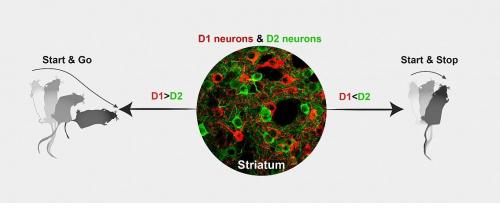NIH scientists develop novel technique to study brain disease
A new tool developed by researchers at the National Institutes of Health has determined, for the first time, how two distinct sets of neurons in the mouse brain work together to control movement. The method, called spectrally resolved fiber photometry (SRFP), can be used to measure the activity of these neuron groups in both healthy mice and those with brain disease. The scientists plan to use the technique to better understand what goes wrong in neurological disorders, such as Parkinson’s disease.

The striatum, part of the brain’s basal ganglia, is involved in movement control. Using the SRFP technique, Cui’s team found that different activity patterns in D1 (red) and D2 (green) pathways led to different types of movement.
According to Guohong Cui, M.D., Ph.D., head of the In Vivo Neurobiology Group at the National Institute of Environmental Health Sciences (NIEHS), part of NIH, the project began because he wanted to find out why patients with Parkinson’s disease have problems with movement. Typically, the disease motor symptoms include tremor, muscle stiffness, slowness of movement, and impaired balance.
Cui explained that an animal’s ability to move was controlled by two groups of neurons in the brain called the direct pathway (D1) and indirect pathway (D2). Based on clinical studies of patients with Parkinson’s and primate models, some researchers hypothesized that the loss of the neurotransmitter dopamine in the midbrain resulted in an imbalance of neural activities between D1 and D2. Since previous methods could not effectively distinguish different cell types in the brain, the hypothesis remained under debate. However, using SRFP, Cui’s team was able to label D1 and D2 neurons with green and red fluorescent sensors to report their neural activity.
"Our method allowed us to simultaneously measure neural activity of both pathways in a mouse as the animal performed tasks," Cui said. "In the future, we could potentially use SRFP to measure the activity of several cell populations utilizing various colors and sensors."
With SRFP, Cui and colleagues found that when neural activity in D1 neurons is stronger than D2 neurons, the animal does a start and go, which means it starts and moves to another location. But, when the activity of D2 neurons is stronger than D1 neurons, the mouse does a start and stop, meaning it initiates a movement, but stops immediately.
Cui said both movements are normal for mice and analyzing them may help researchers predict what kind of movement the animal will make based on its neural activity. This advance may help explain what happens in the brains of mice with Parkinson’s.
Two of Cui’s team members, NIEHS Visiting Fellows Chengbo Meng, Ph.D., and Jingheng Zhou, Ph.D., share first-authorship of the Neuron article.
"The traditional method of electrophysiological recording is good when you want to measure electrical outputs of neurons, but it cannot tell you what type of neurons are generating those signals," Meng said. "SRFP is more specific, because we can distinguish between groups of neurons and see their activity."
While Cui’s group is mainly interested in understanding Parkinson’s disease, Zhou said SRFP will help researchers studying other brain conditions, such as Alzheimer’s disease, stroke, multiple sclerosis, and addiction.
Basic research increases our understanding of human behavior and biology, which is foundational to advancing new and better ways to prevent, diagnose, and treat disease. Science is an unpredictable and incremental process — each research advance builds on past discoveries, often in unexpected ways. Most clinical advances would not be possible without the knowledge of fundamental basic research.
Source: U.S. National Institutes of Health
- 229 reads
Human Rights
Ringing FOWPAL’s Peace Bell for the World:Nobel Peace Prize Laureates’ Visions and Actions

Protecting the World’s Cultural Diversity for a Sustainable Future

The Peace Bell Resonates at the 27th Eurasian Economic Summit

Declaration of World Day of the Power of Hope Endorsed by People in 158 Nations

Puppet Show I International Friendship Day 2020

